Compatibility and Possibility of New Ornamental Geophytes for Their Utilization in Landscape Architecture
Abstract
:1. Introduction
2. Material and Methods
2.1. Plant Materials and Growth Conditions
2.2. Optimal Planting Time
2.3. Measurements
2.4. Experimental Design and Statistical Analysis
3. Results
3.1. Descriptive Statistics
3.2. Cost of Ornamental Geophytes
3.3. Flowering Time
3.4. Flower Longevity
3.5. Bulb Sprouting Time
3.6. Visual Quality
3.7. Correlation Coefficient Analysis
3.8. Cluster Analysis
3.9. Regression Liner Analysis
4. Discussion
5. Conclusions
Supplementary Materials
Author Contributions
Funding
Data Availability Statement
Conflicts of Interest
References
- Karimian, Z. Native plants in the urban landscape. FOP 2016, 4, 78–86. (In Persian) [Google Scholar]
- Yener, D.; Seyidoğlu Akdeniz, N. Evaluation of the natural geophyte taxa of Sarıyer (Istanbul) and their use in urban landscape. Eurasian J. For. Sci. 2020, 8, 93–107. [Google Scholar]
- Kang, J.; Shibata, S.A. dispersed vegetative cover contributes to urban biodiversity: Plant diversity across land use types and scale in an Asian city. J. For. Res. 2023, 34, 539–551. [Google Scholar] [CrossRef]
- Heidari Asl, E.; Maeerofi, E.R. Green space and its standards with a strategic view of hot and dry regions of Iran. J. NAJA Deputy. Eng. 2016, 54, 99–129. (In Persian) [Google Scholar]
- Baiyewu, R.A.; Amusa, N.A.; Olayiwola, O. Survey on the use of ornamental plants for environmental management in southwestern Nigeria. RJABS 2005, 1, 237–240. [Google Scholar]
- Hall, C.R.; Hodges, A.W. Economic, environmental and well-being benefits of lifestyle horticulture. Chron. Horticult. 2011, 51, 5–8. [Google Scholar]
- Summers, J.K.; Smith, L.M.; Case, J.L.; Linthurst, R.A. A review of the elements of human well-being with an emphasis on the contribution of ecosystem services. AMBIO 2012, 41, 327–340. [Google Scholar] [CrossRef]
- Ciftcioglu, G.C. Assessment of the relationship between ecosystem services and human wellbeing in the social-ecological landscapes of Lefke Region in North Cyprus. Landsc. Ecol. 2017, 32, 897–913. [Google Scholar] [CrossRef]
- Maller, C.; Townsend, M.; St Leger, L.; Henderson-Wilson, C.; Pryor, A.; Prosser, L.; Moore, M. Healthy parks, healthy people: The health benefits of contact with nature in a park context. Georg. Wright Forum. 2009, 26, 51–83. [Google Scholar]
- Gopal, D.; Nagendra, H. Vegetation in Bangalore’s slums: Boosting livelihoods, well-being and social capital. Sustainability 2014, 6, 2459–2473. [Google Scholar] [CrossRef]
- Francini, A.; Romano, D.; Toscano, S.; Ferrante, A. The Contribution of Ornamental Plants to Urban Ecosystem Services. Earth 2022, 3, 1258–1274. [Google Scholar] [CrossRef]
- Potenza, G.; Vairo, F.; Castronuovo, D.; Fascetti, S.; Candido, V. Use of Native Geophytes of Ornamental Interest: The Case Study of Sternbergia lutea (L.) Ker. Gawl. Ex Spreng. Biol. Life Sci. Forum. 2021, 11, 34. [Google Scholar]
- Farahmand, H.; Nazari, F. Environmental and Anthropogenic Pressures on Geophytes of Iran and the Possible Protection Strategies: A Review. Int. J. Hortic. Sci. Technol. 2015, 2, 111–132. [Google Scholar]
- Dehertogh, A.; LeNard, M. The Physiology of Flower Bulbs; Elsevier Science Publishers: Amsterdam, The Netherlands, 1993; 812p. [Google Scholar]
- Taghizadeh, K.; Minaei, E. How to select plants in the planning and architecture of urban landscapes in Iran. Hum. Geogr. Res. 2012, 81, 127–140. (In Persian) [Google Scholar]
- Salehi Sardoei, A.; Mohammadi, G.A.; Rahbarian, P. Interaction Effect of Salicylic Acid and Putrescine on Vase life of Cut Narcissus Flowers. Int. J. Adv. Biol. Biomed. Res. 2013, 1, 1569–1576. [Google Scholar]
- Ferrante, A.; Hunter, D.A.; Hackett, W.P.; Reid, M.S. Thidiazuron-a potent inhibitor of leaf senescence in alstroemeria. Postharvest Biol. Technol. 2012, 25, 333–338. [Google Scholar] [CrossRef]
- Bahrehmand, S.; Razmjoo, J.; Farahmand, H. Effects of Nano-Silver and Sucrose applications on Cut Flower Longevity and Quality of Tuberose (Polianthus tuberosa). Int. J. Hortic. Sci. Technol. 2014, 1, 67–77. [Google Scholar]
- Golshadi Ghale-shahi, Z.; Babarabie, M.; Zarei, H.; Danyaei, A. Investigating the Potential of Increasing the Vase Life of Cut Flower of Narcissus by Using Sour Orange Fruit Extract and Sucrose in the Storage Conditions. JOP 2015, 5, 21–28. [Google Scholar]
- Chope, G.; Terry, L.; White, P. Effect of controlled atmosphere storage on abscisic acid concentration and other biochemical attributes of onion bulbs. Postharvest Biol. Technol. 2006, 39, 233–242. [Google Scholar] [CrossRef]
- Akhtar, G.; Shehzad, M.A.; Faried, H.N.; Ullah, S.; Razzaq, K.; Ahsan, M.; Sajjad, Y. Evaluation of new cultivars of Gladiolus grandiflorus grown in subtropical conditions for their post-harvest performance and growth traits. N. Z. J. Crop Hortic. Sci. 2023, 1–16. [Google Scholar] [CrossRef]
- Dafni, A.; Shmida, A.; Avishai, M. Leafless autumnal-flowering geophytes in the Mediterranean region phytogeographical, ecological and evolutionary aspects. Plant Syst. Evol. 1981, 137, 181–198. [Google Scholar] [CrossRef]
- Arslan, N.; Gurbuz, B.; Gumuocu, A.; Ozcan, S.; Mirici, S.; Khawar, K.M. Cultivation of Stenbergia fischeriana herbert Rupr. and a study on its morphological characteristic. Pak. J. Bot. 2002, 4, 411–418. [Google Scholar]
- Mirici, S.; Parmaks, I.; Ozcan, S.; Sancak, C.; Uranbey, S. Efficient in vitro bulblet regeneration from immature embryos of endangered Sternbergia fischeriana. Plant Cell Tiss. Org. Cult. 2005, 80, 239–246. [Google Scholar] [CrossRef]
- Arzu, A. Benefit From Natural Plants In Landscape Architecture: Example of Siirt Geophytes. ISPEC J. Agric. Sci. 2020, 4, 260–271. [Google Scholar]
- El Merzougui, S.; Benelli, C.; El Boullani, R.; Serghini, M.A. The Cryopreservation of Medicinal and Ornamental Geophytes: Application and Challenges. Plants 2023, 12, 2143. [Google Scholar] [CrossRef]
- Yuan, J.; Zhang, L.; Kim, C.-S. Multimodal Interaction of MU Plant Landscape Design in Marine Urban Based on Computer Vision Technology. Plants 2023, 12, 1431. [Google Scholar] [CrossRef] [PubMed]
- Kamenetsky, R.; Gude, H.; Chastagner, G.A.; Okubo, H. Research challenges in geophyte science: From basic science to sustainable production. Acta Hortic. 2015, 1104, 119–129. [Google Scholar] [CrossRef]
- Gilford, J.M.D.; Rees, A.R. The tulip shoot apex. I. Structure and development. Sci. Hort. 1974, 2, 1–10. [Google Scholar] [CrossRef]
- Noy-Porat, T.; Flaishman, A.; Eshel, A.; Sandler-Ziv, D.; Kamenetsky, R. Florogenesis of the Mediterranean geophyte Narcissus tazetta and temperature requirements for flower initiation and differentiation. Sci. Hort. 2009, 120, 138–142. [Google Scholar] [CrossRef]
- Mirzadeh Vaghefi, S.S.; Jalili, A. Native plants with ornamental potential for planting in urban green space of Tehran. FOP 2020, 4, 131–142. [Google Scholar] [CrossRef]
- Shooshtarian, S.; Salehi, H.; Tehranifar, A. Study of growth and development features of ten ground cover plants in Kish Island green space in warm season. J. Agroecol. 2011, 3, 514–524. [Google Scholar]
- Zencirkiran, M.; Tumsavas, Z. Effect of Bulb Circumference on Bulb Yield and Bulbet Formation Capacity of Sternbergia lutea (L.) Ker-Gawl. Ex Sprengel (Winter Daffodil). Pak. J. Biol. Sci. 2006, 9, 2366–2368. [Google Scholar] [CrossRef]
- Zubair, M.; Wazir, F.K.; Akhtar, S.; Ayub, G. Planting dates affect floral characteristics of gladiolus under the soil and climatic conditions of Peshawar. Pak. J. Biol. Sci. 2006, 9, 1669–1676. [Google Scholar]
- Dod, V.N.; Sadawartr, K.T.; Kulwal, L.V.; Vaidya, S.W. Effects of different dates of planting and size of corm on growth and flower yield of gladiolus. P.K.V. Res. J. 1989, 13, 164–165. [Google Scholar]
- Cheng, F.; Zhong, Y.; Long, F.; Yu, X.; Kamenetsky, R. Chinese herbaceous peonies: Cultivar selection for forcing culture and effects of chilling and gibberellin (GA3) on plant development, Isr. J. Plant Sci. 2009, 57, 357–367. [Google Scholar] [CrossRef]
- Zencirkiran, M. Geophytes; Publication of Uludag Rotary Association: Istanbul, Turkey, 2002; p. 105. [Google Scholar]
- Ansari, H.; Naderianfar, M.; Ramazani, H.; Joleini, M. Comparison and Evaluation Some of Growth Indices of The Dominant Species of Urban landscapes in The Jar Subsurface, Drip and Surface Irrigation Systems. Iran. J. Irrig. Drain. 2014, 8, 402–412. [Google Scholar]
- Hansen, G. Landscape Design: Arranging Plants in the Landscape; ENH1188, the 144 Environmental Horticulture Department, UF/IFAS Extension; University of Florida Press: Gainesville, FL, USA, 2011. [Google Scholar]
- Karaşah, B.; Var, M. Trabzon ve bazı ilçelerinde kent dokusundaki bitkilendirme tasarımlarının ölçü–form açısından irdelenmesi. BAROFD 2012, 14, 1–11. [Google Scholar]
- Alp, S.; Aşur, F.; Aytin, O.F. Van kentinde kamusal yeşil alanların düzenlemelerinde kullanılan mevsimlik ve soğanlı bitkilerin peyzaj mimarlığı açısından değerlendirilmesi. In VI. Sus Bitkileri Kongresi, 19-22 Nisan, Muratpaşa, Antalya; Batı Akdeniz Agricultural Research Institute: Antalya, Turkey, 2016; pp. 140s–144s. [Google Scholar]
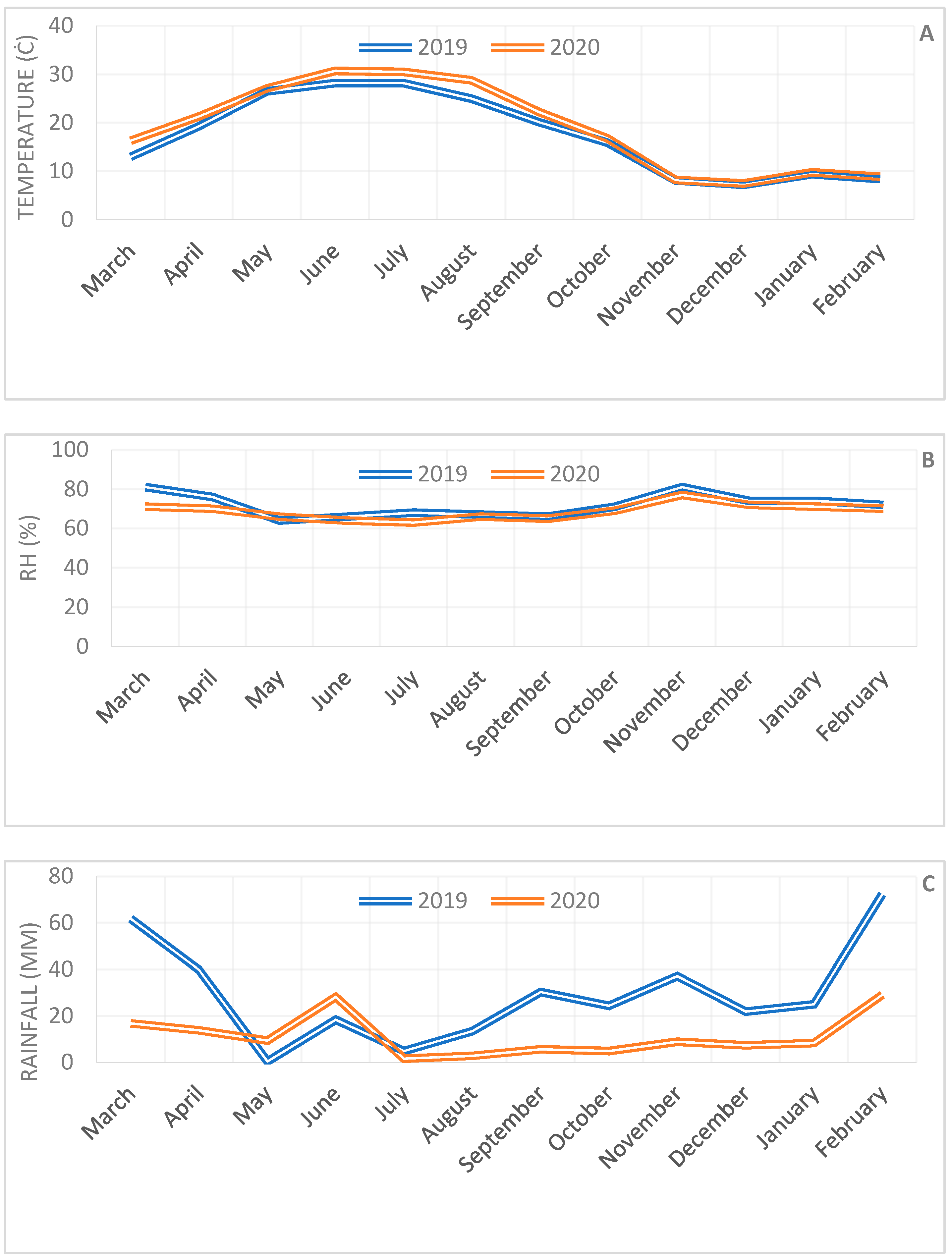

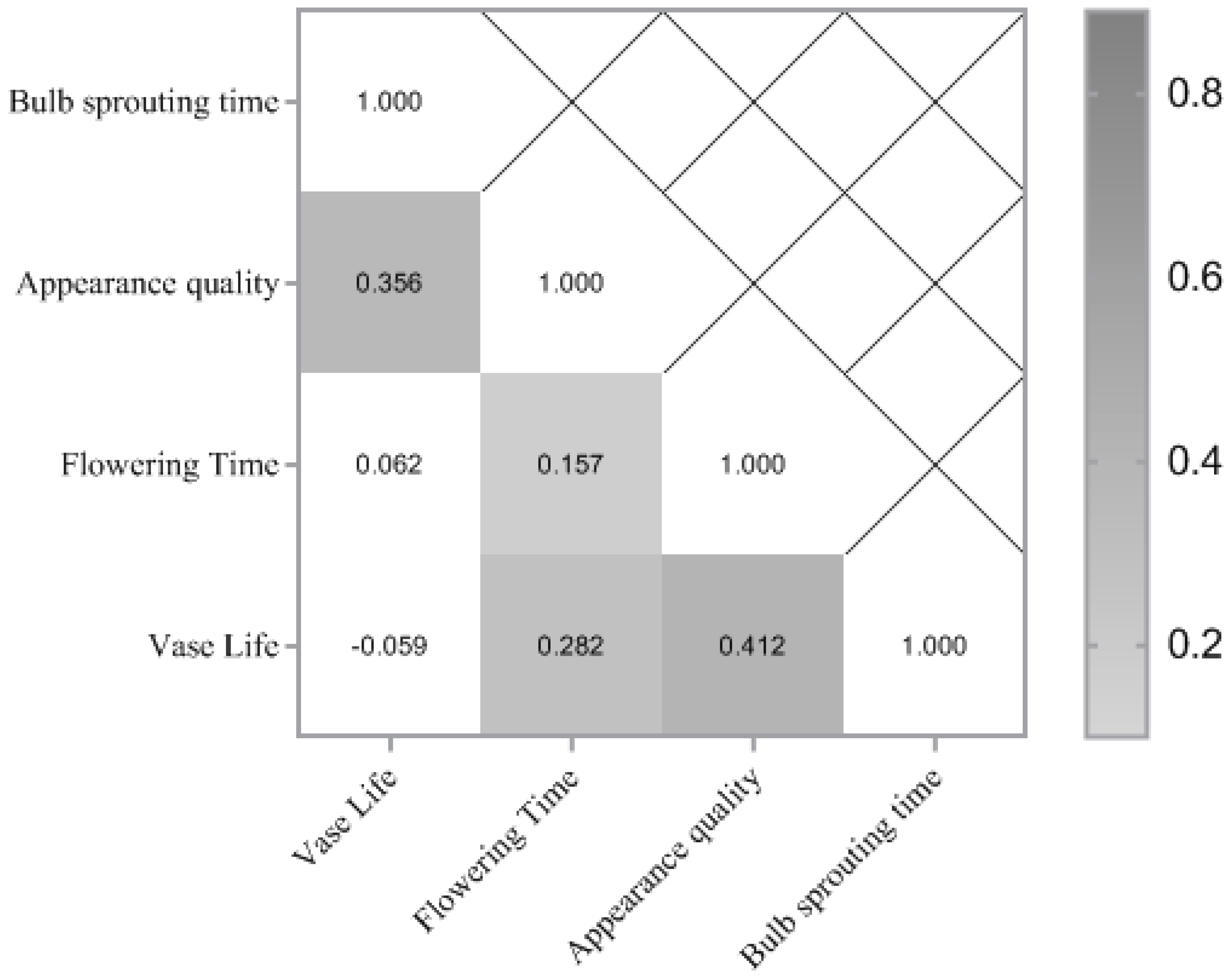
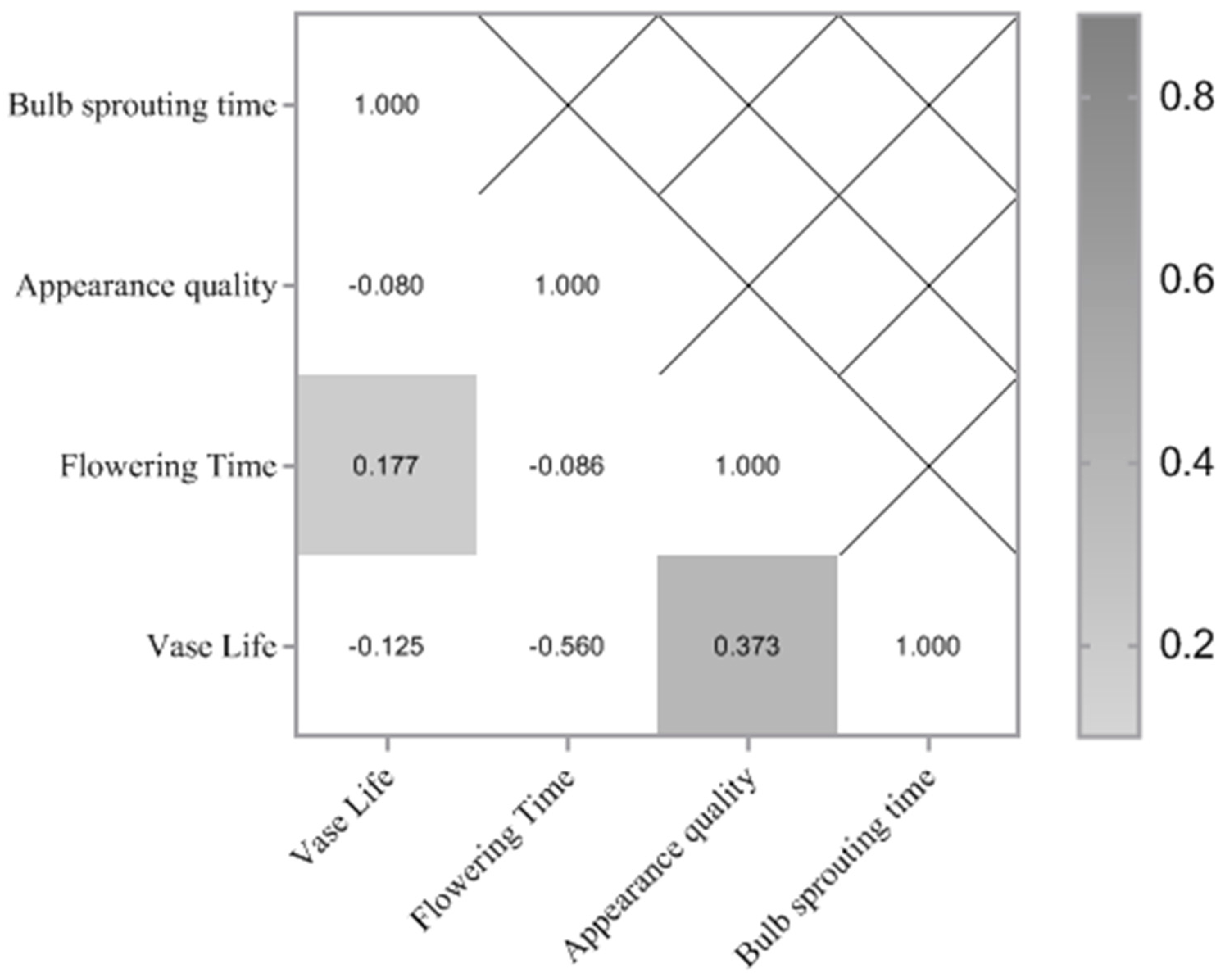


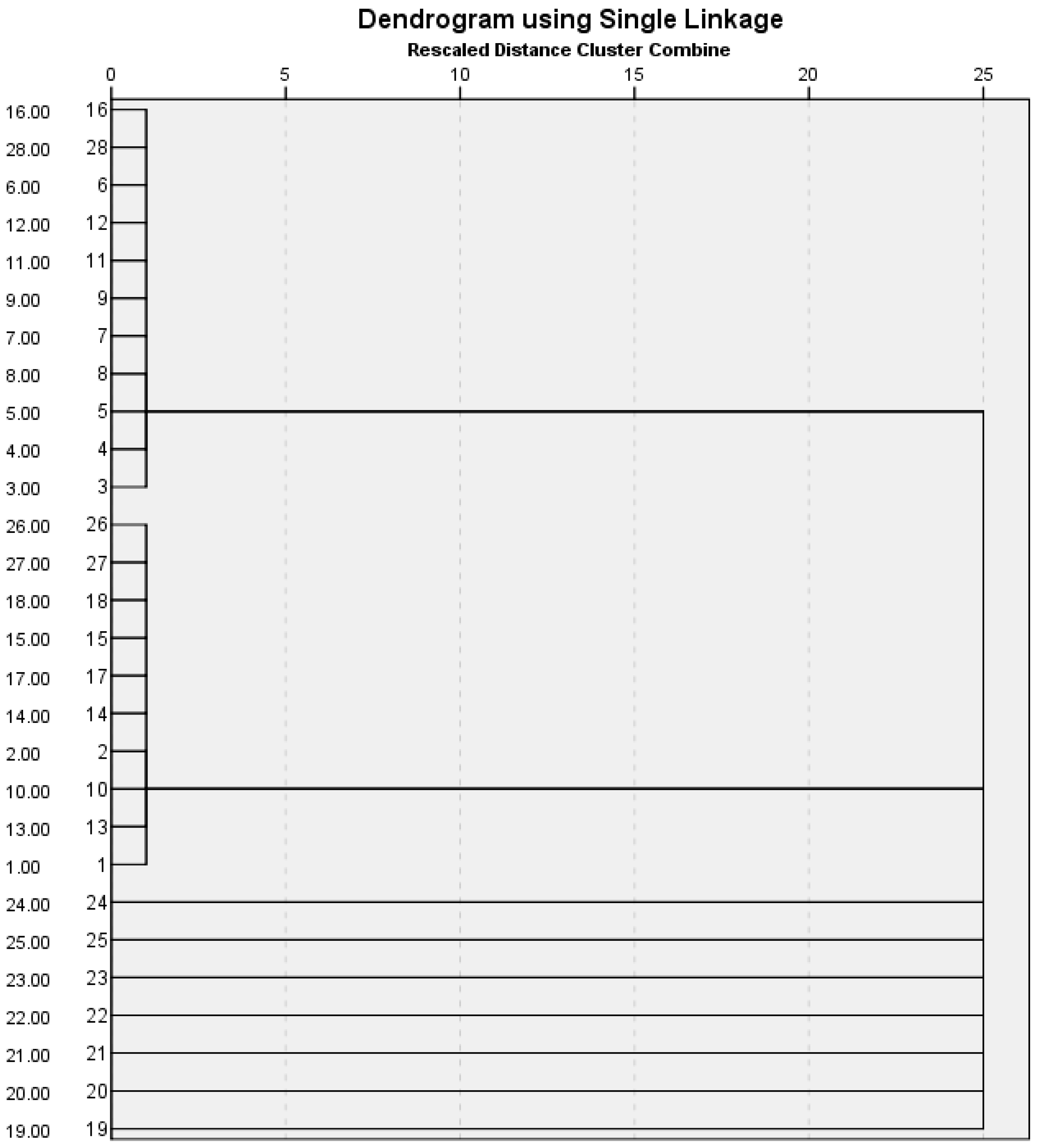

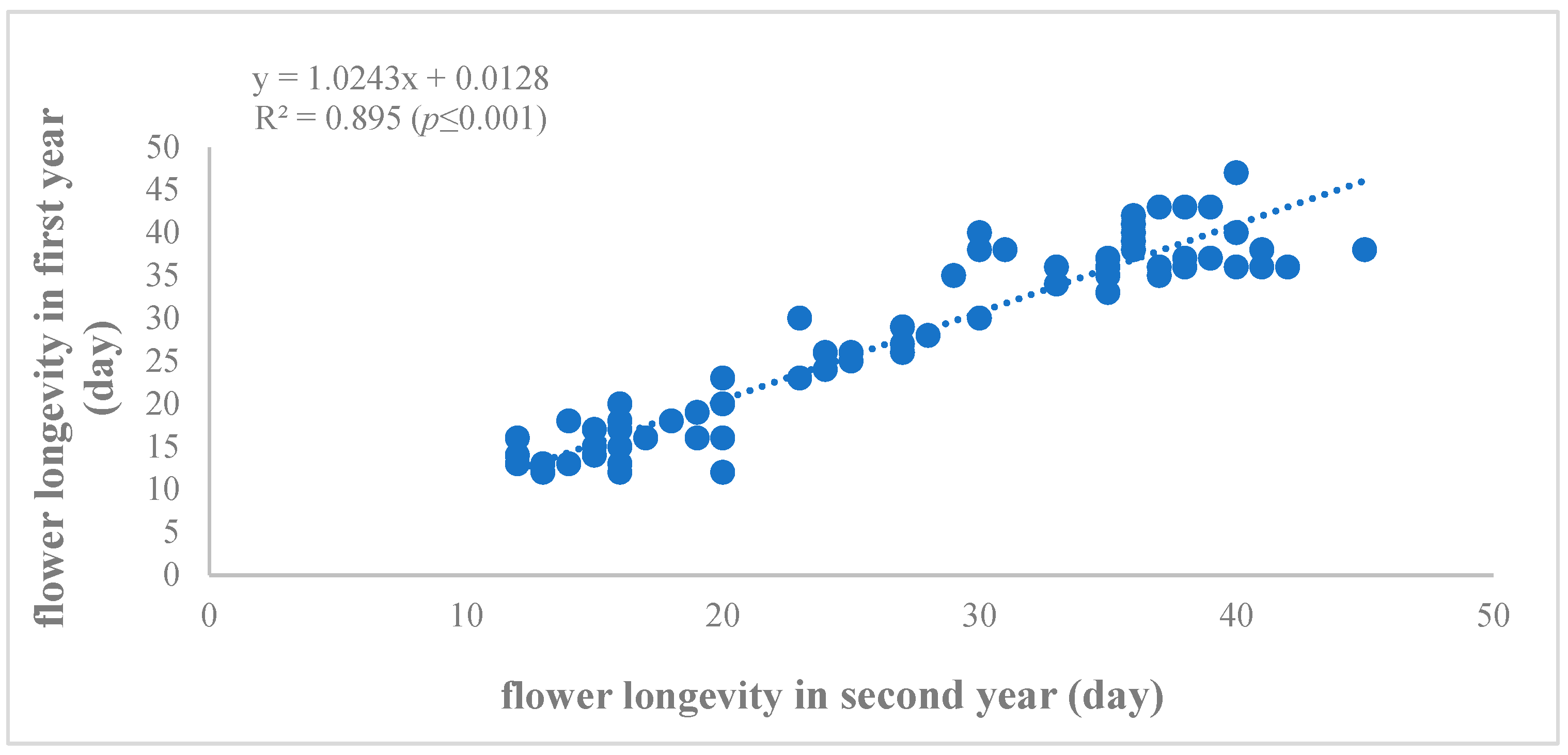

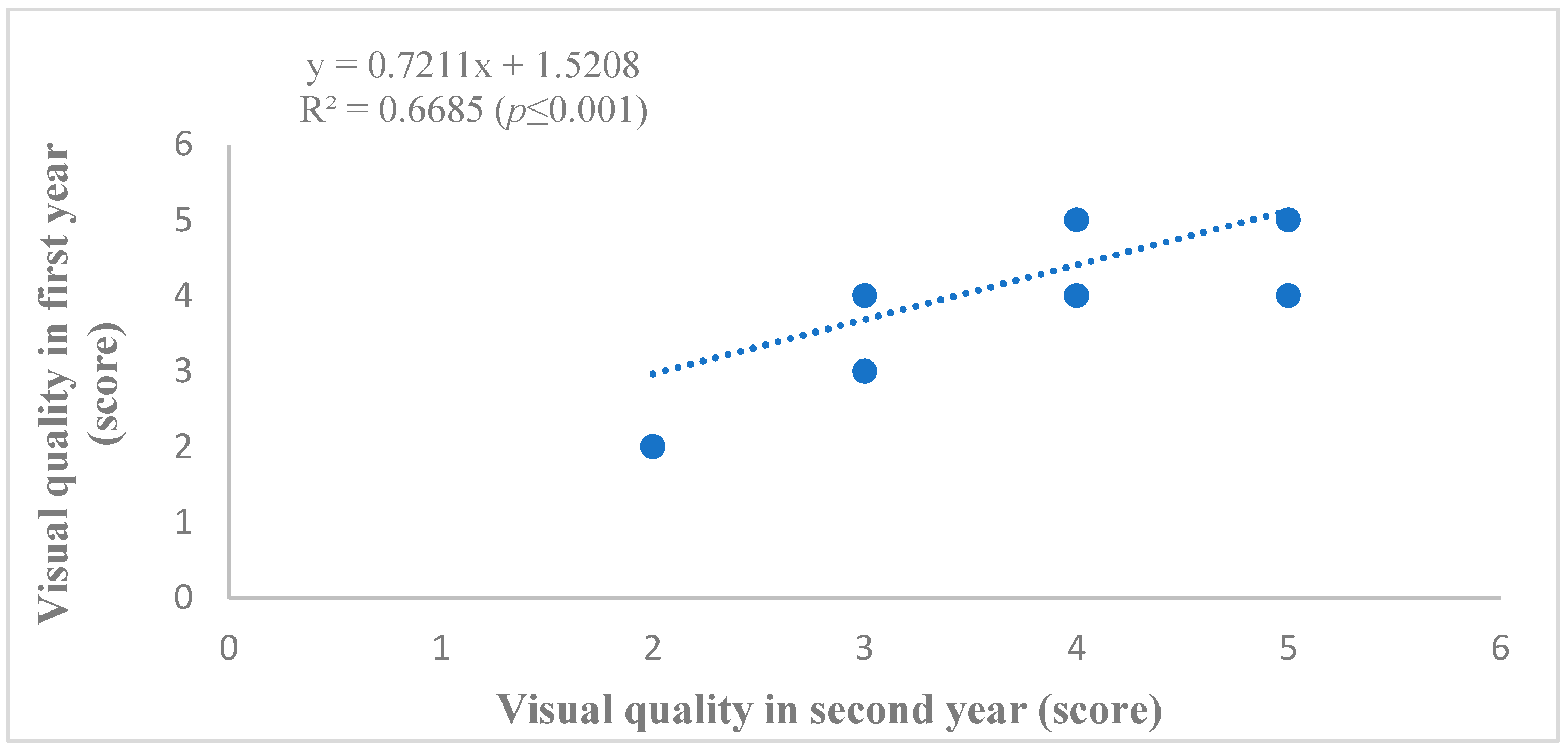

| First Year | Second Year | |||||
|---|---|---|---|---|---|---|
| Morpho-Physiological Variables | Minimum | Maximum | Mean ± Standard Deviation | Minimum | Maximum | Mean ± Standard Deviation |
| Bulb sprouting time (days) | 6 | 68 | 20.64 ± 12.31 | 11 | 68 | 24.13 ± 10.662 |
| Visual quality (score) | 2 | 5 | 4.05 ± 0.95 | 2 | 5 | 4.45 ± 0.84 |
| Flowering time (days) | 64 | 389 | 129.71 ± 67.41 | 12 | 235 | 125.03 ± 45.23 |
| Flower longevity (days) | 12 | 45 | 26.24 ± 9.51 | 12 | 47 | 26.83 ± 10.23 |
| Scientific Name | Price of Single Geophyte (USD) | Total Price per Square Meter (USD) |
|---|---|---|
| Polianthes tuberosa | 0.06 | 1.44 |
| Crocosmia aurea | 0.12 | 1.44 |
| Hedychium coronarium | 0.08 | 0.96 |
| Alstroemeria aurea | 0.7 | 16.8 |
| Freesia refracta | 0.1 | 2.4 |
| Narcissus tazetta Narcissus jonquilla | 0.07 | 1.68 |
| Hyacinthus orientalis | 0.6 | 19.2 |
| Tulipa gesneriana | 0.26 | 8.32 |
| Iris × hollandica | 0.08 | 1.92 |
| Dahlia pinnata | 0.28 | 5.60 |
| Gladiolus hybrida | 0.1 | 2.4 |
| Canna indica | 0.12 | 1.44 |
| Species | First Year (Day) | Second Year (Day) |
|---|---|---|
| Alstroemeria aurea cv. Balance | 320.0 b | 107.3 h–m |
| Gladiolus hybrida cv. Alexander | 100.6 mn | 79.0 n–p |
| Gladiolus hybrida cv. Rose Supreme | 95.6 n | 100.6 h–m |
| Dahlia pinnata cv. Red Runner | 146.6 e | 195.3 b |
| Dahlia pinnata cv. Mystic Illusion | 134.6 f | 185.3 b |
| Dahlia pinnata cv. Aragon | 120.3 g | 152.0 cd |
| Polianthes tuberosa cv. Mahallati | 99.6 mn | 142.3 c–e |
| Polianthes tuberosa cv. Pearl | 110.6 hi | 118.6 f–h |
| Polianthes tuberosa cv. Majesty | 118.3 gh | 130.3 e–g |
| Canna indica cv. Flaccida | 107.0 im | 87.6 m–o |
| Canna indica cv. Striped Beauty | 132.6 f | 158.6 c |
| Canna indica cv. Phasion | 114.0 g–i | 136.0 d–f |
| Crocosmia aurea cv. Aurora | 381.6 a | 231.0 a |
| Freesia refracta cv. Ambassador | 159.6 d | 149.3 c–e |
| Freesia refracta cv. Bastogne | 158.0 d | 141.6 c–e |
| Freesia refracta cv. Red beauty | 145.0 e | 152.0 cd |
| Freesia refracta cv. Pink Passion | 161.0 d | 154.6 cd |
| Iris × hollandica cv. Blue Magic | 209.0 c | 197.3 b |
| Hyacinthus orientalis cv. Blue Jacket | 72.6 pq | 72.6 op |
| Hyacinthus orientalis cv. Fondant | 66.6 qr | 66.6 op |
| Hyacinthus orientalis cv. Aiolos | 76.0 o | 76.0 n–p |
| Hyacinthus orientalis cv. Blue Roman | 70.0 p–r | 70.0 op |
| Tulipa gesneriana cv. Buster | 64.3 s | 64.3 p |
| Tulipa gesneriana cv. Strong Gold | 75.6 o | 75.6 n–p |
| Tulipa gesneriana cv. Irani | 112.0 hi | 112.0 g–i |
| Narcissus tazetta | 112.0 hi | 104.6 h–m |
| Narcissus paperwhite | 100.3 mn | 95.3 i–n |
| Narcissus jonquilla | 130.3 f | 138.6 c–f |
| Species | First Year (Days) | Second Year (Days) |
|---|---|---|
| Alstroemeria aurea cv. Balance | 38.0 a–c | 43.0 a |
| Gladiolus hybrida cv. Alexander | 12.6 m | 13.0 o |
| Gladiolus hybrida cv. Rose Supreme | 19.3 h | 16.0 mn |
| Dahlia pinnata cv. Red Runner | 31.6 d | 35.0 f |
| Dahlia pinnata cv. Mystic Illusion | 30.3 de | 38.6 b–d |
| Dahlia pinnata cv. Aragon | 36.0 c | 41.0 ab |
| Polianthes tuberosa cv. Mahallati | 15.0 im | 17.6 im |
| Polianthes tuberosa cv. Pearl | 16.0 i | 17.3 i–n |
| Polianthes tuberosa cv. Majesty | 14.6 im | 16.3 mn |
| Canna indica cv. Flaccida | 16.0 i | 14.6 no |
| Canna indica cv. Striped Beauty | 15.0 im | 13.0 o |
| Canna indica cv. Phasion | 16.0 i | 12.6 o |
| Crocosmia aurea cv. Aurora | 35.6 c | 39.3 bc |
| Freesia refracta cv. Ambassador | 37.0 bc | 35.3 ef |
| Freesia refracta cv. Bastogne | 39.6 ab | 36.6 c–f |
| Freesia refracta cv. Red beauty | 25.3 fg | 26.0 g |
| Freesia refracta cv. Pink Passion | 40.6 a | 38.0 c–e |
| Iris × hollandica cv. Blue Magic | 23.3 g | 27.3 g |
| Hyacinthus orientalis cv. Blue Jacket | 19.3 h | 19.3 i |
| Hyacinthus orientalis cv. Fondant | 23.3 g | 23.3 h |
| Hyacinthus orientalis cv. Aiolos | 17.6 hi | 17.6 im |
| Hyacinthus orientalis cv. Blue Roman | 28.0 ef | 28.0 g |
| Tulipa gesneriana cv. Buster | 27.6 ef | 27.6 g |
| Tulipa gesneriana cv. Strong Gold | 27.6 ef | 27.6 g |
| Tulipa gesneriana cv. Irani | 18.0 hi | 18.0 im |
| Narcissus tazetta | 39.6 ab | 36.0 d–f |
| Narcissus paperwhite | 35.0 c | 34.6 f |
| Narcissus jonquilla | 39.6 ab | 43.3 a |
| Species | First Year (Days) | Second Year (Days) |
|---|---|---|
| Alstroemeria aurea cv. Balance | 16 f–h | 18 o–s |
| Gladiolus hybrida cv. Alexander | 6.33 q | 18.33 n–s |
| Gladiolus hybrida cv. Rose Supreme | 6.66 q | 16 s |
| Dahlia pinnata cv. Red Runner | 9.67 p | 18.6 m–r |
| Dahlia pinnata cv. Mystic Illusion | 11 op | 21.6 f–h |
| Dahlia pinnata cv. Aragon | 10.33 op | 20.6 g–n |
| Polianthes tuberosa cv. Mahallati | 13.67 mn | 20 h–q |
| Polianthes tuberosa cv. Pearl | 16 fgh | 21.3 f–h |
| Polianthes tuberosa cv. Majesty | 13.33 n | 20.3 h–p |
| Canna indica cv. Flaccida | 21.66 de | 32 d |
| Canna indica cv. Striped Beauty | 21.66 de | 30 d |
| Canna indica cv. Phasion | 21.33 e | 22.3 fg |
| Crocosmia aurea cv. Aurora | 20 e | 27.3 e |
| Freesia refracta cv. Ambassador | 11.33 o | 12.3 t |
| Freesia refracta cv. Bastogne | 14.33 i–n | 17.6 p–s |
| Freesia refracta cv. Red beauty | 15 h–m | 17.3 q–s |
| Freesia refracta cv. Pink Passion | 17.33 f | 19.6 i–q |
| Iris × hollandica cv. Blue Magic | 52.66 b | 45.6 b |
| Hyacinthus orientalis cv. Blue Jacket | 16.67 fg | 16.6 rs |
| Hyacinthus orientalis cv. Fondant | 20 e | 20 h–q |
| Hyacinthus orientalis cv. Aiolos | 23 cd | 23 f |
| Hyacinthus orientalis cv. Blue Roman | 20 e | 20 h–q |
| Tulipa gesneriana cv. Buster | 17.33 f | 17.3 q–s |
| Tulipa gesneriana cv. Strong Gold | 17.33 | 21 f–i |
| Tulipa gesneriana cv. Irani | 21 e | 66.6 a |
| Narcissus tazetta | 66.66 a | 18 o–s |
| Narcissus paperwhite | 15.33 g–i | 21.3 f–h |
| Narcissus jonquilla | 23.33 c | 39.3 c |
| Species | First Year (Score 1–5) | Second Year (Score 1–5) |
|---|---|---|
| Alstroemeria aurea cv. Balance | 5 a | 4 b |
| Gladiolus hybrida cv. Alexander | 3 c | 4 b |
| Gladiolus hybrida cv. Rose Supreme | 4 b | 5 a |
| Dahlia pinnata cv. Red Runner | 3 c | 4 b |
| Dahlia pinnata cv. Mystic Illusion | 3 c | 4 b |
| Dahlia pinnata cv. Aragon | 3 c | 4 b |
| Polianthes tuberosa cv. Mahallati | 3 c | 4 b |
| Polianthes tuberosa cv. Pearl | 4 b | 5 a |
| Polianthes tuberosa cv. Majesty | 3 c | 4 b |
| Canna indica cv. Flaccida | 4 b | 5 a |
| Canna indica cv. Striped Beauty | 4 b | 5 a |
| Canna indica cv. Phasion | 5 a | 5 a |
| Crocosmia aurea cv. Aurora | 5 a | 5 a |
| Freesia refracta cv. Ambassador | 4 b | 5 a |
| Freesia refracta cv. Bastogne | 4 b | 5 a |
| Freesia refracta cv. Red beauty | 4 b | 5 a |
| Freesia refracta cv. Pink Passion | 5 a | 5 a |
| Iris × hollandica cv. Blue Magic | 5 a | 5 a |
| Hyacinthus orientalis cv. Blue Jacket | 5 a | 5 a |
| Hyacinthus orientalis cv. Fondant | 5 a | 5 a |
| Hyacinthus orientalis cv. Aiolos | 5 a | 5 a |
| Hyacinthus orientalis cv. Blue Roman | 4 b | 4 b |
| Tulipa gesneriana cv. Buster | 5 a | 5 a |
| Tulipa gesneriana cv. Strong Gold | 5 a | 5 a |
| Tulipa gesneriana cv. Irani | 4 b | 4 b |
| Narcissus tazetta | 5 a | 5 a |
| Narcissus paperwhite | 5 a | 5 a |
| Narcissus jonquilla | 5 a | 5 a |
Disclaimer/Publisher’s Note: The statements, opinions and data contained in all publications are solely those of the individual author(s) and contributor(s) and not of MDPI and/or the editor(s). MDPI and/or the editor(s) disclaim responsibility for any injury to people or property resulting from any ideas, methods, instructions or products referred to in the content. |
© 2023 by the authors. Licensee MDPI, Basel, Switzerland. This article is an open access article distributed under the terms and conditions of the Creative Commons Attribution (CC BY) license (https://creativecommons.org/licenses/by/4.0/).
Share and Cite
Babarabie, M.; Sardoei, A.S.; Jamali, B.; Hatami, M.; Nicola, S.; Devecchi, M. Compatibility and Possibility of New Ornamental Geophytes for Their Utilization in Landscape Architecture. Horticulturae 2024, 10, 3. https://doi.org/10.3390/horticulturae10010003
Babarabie M, Sardoei AS, Jamali B, Hatami M, Nicola S, Devecchi M. Compatibility and Possibility of New Ornamental Geophytes for Their Utilization in Landscape Architecture. Horticulturae. 2024; 10(1):3. https://doi.org/10.3390/horticulturae10010003
Chicago/Turabian StyleBabarabie, Mehrdad, Ali Salehi Sardoei, Babak Jamali, Mehrnaz Hatami, Silvana Nicola, and Marco Devecchi. 2024. "Compatibility and Possibility of New Ornamental Geophytes for Their Utilization in Landscape Architecture" Horticulturae 10, no. 1: 3. https://doi.org/10.3390/horticulturae10010003
APA StyleBabarabie, M., Sardoei, A. S., Jamali, B., Hatami, M., Nicola, S., & Devecchi, M. (2024). Compatibility and Possibility of New Ornamental Geophytes for Their Utilization in Landscape Architecture. Horticulturae, 10(1), 3. https://doi.org/10.3390/horticulturae10010003








